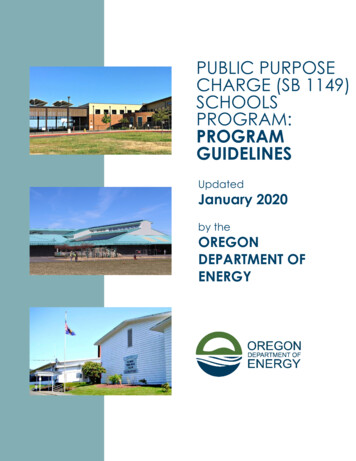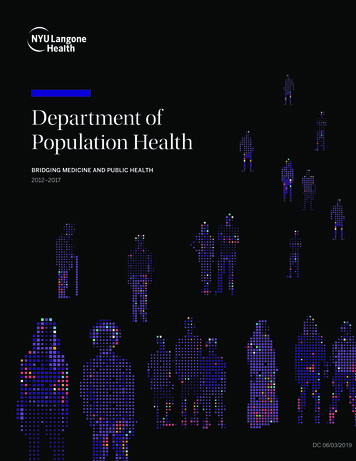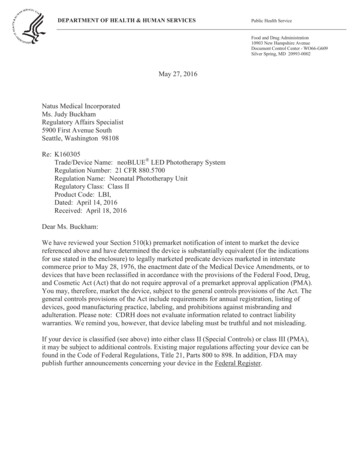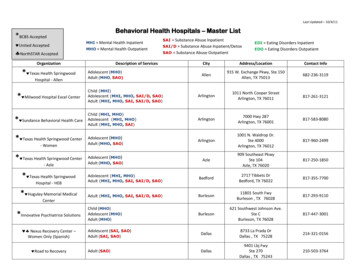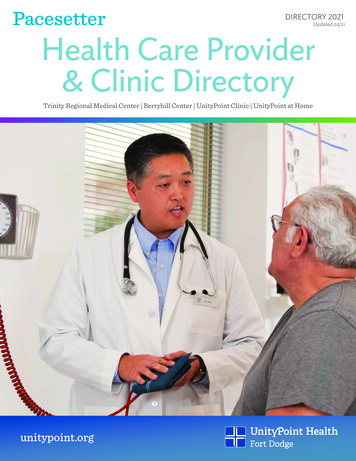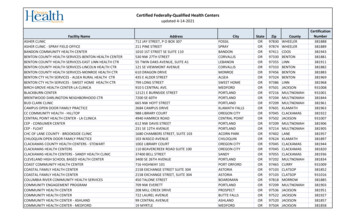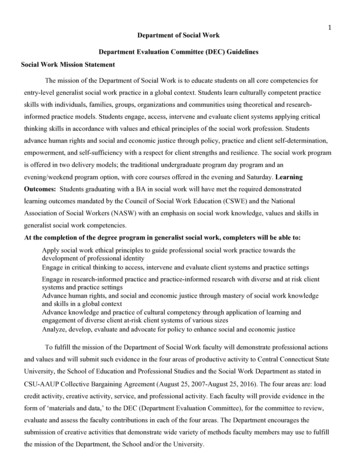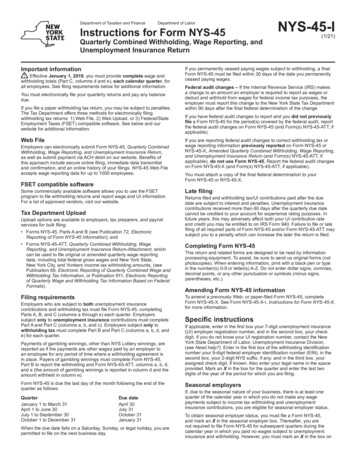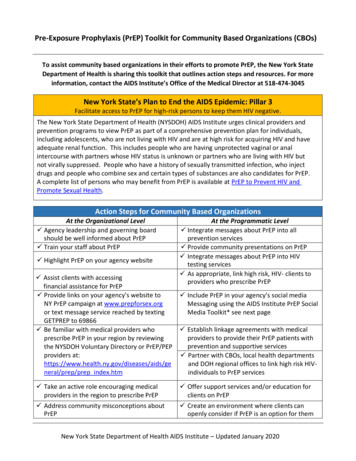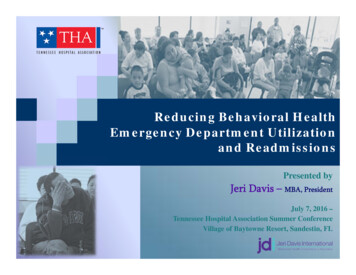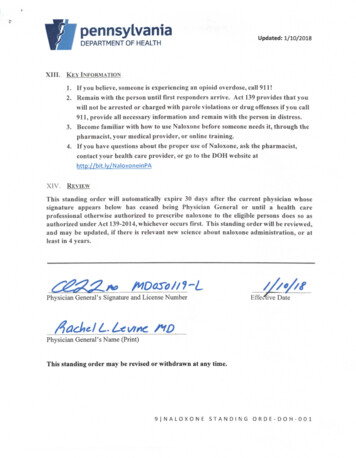
Transcription
PennsylvaniaUpdated:1/10/2018DEPARTMENT OF HEALTHXIII. KEY INFORMATION1. If you believe, someone is experiencing an opioid overdose, call 911!2. Remain with the person until first responders arrive. Act 139 provides that youwill not be arrested or charged with parole violations or drug offenses if you call911, provide all necessary information and remain with the person in distress.3. Become familiar with how to use Naloxone before someone needs it, through thepharmacist, your medical provider, or online training.4. If you have questions about the proper use of Naloxone, ask the pharmacist,contact your health care provider, or go to the DOH website athttp://bit.lv/NaloxoneinPAXIV.REVIEWThis standing order will automatically expire 30 days after the current physician whosesignature appears below has ceased being Physician General or until a health careprofessional otherwise authorized to prescribe naloxone to the eligible persons does so asauthorized under Act 139-2014, whichever occurs first. This standing order will be reviewed,and may be updated, if there is relevant new science about naloxone administration, or atleast in 4 years.Physician General's Signature and License NumberEffe 4ive DatePhysician General's Name (Print)This standing order may be revised or withdrawn at any time.9 NALOXONESTANDINGORDE-DOH-001
PennsylvaniaDEPARTMENT OF HEALTH" 1/10/2 18STANDING ORDER DOH-001-2018Naloxone Prescription for Overdose PreventionNaloxone Hydrochloride (Naloxone) is a medication indicated for reversal of opioid overdose inthe event of a drug overdose that is the result of consumption or use of one or more opioidrelated drugs causing a drug overdose event.I.PURPOSEThis standing order applies to Commonwealth of Pennsylvania firefighters and law enforcementofficers (collectively Eligible Persons) who are providing care with an employer who meets therequirements under section II below. This standing order does not apply to Department ofHealth (Department) certified emergency medical services (EMS) providers or Departmentlicensed EMS agencies, except as specifically provided herein.II.DEPARTMENT-CERTIFIED EMS PROVIDERS AND DEPARTMENTLICENSED EMS AGENCIESThis standing order authorizes Department-certified EMS providers or Department-licensedEMS agencies who have responded to an individual experiencing an opioid-related overdose (AtRisk Person), and who are therefore in a position to assist that At-Risk Person, to leave behindnaloxone with the At-Risk Person or with family members, friends, or other persons who are in aposition to assist the At-Risk Person, along with instructions to follow the naloxone packageinsert directions and the guidance provided in Standing Order DOH-002-2017, available on theDepartment's website.III.AUTHORITYThis standing order is issued pursuant to Act 139 of 2014 (Act 139) (amending The ControlledSubstance, Drug, Device and Cosmetic Act (35 P.S. §§ 780-101 et seq.}), which permits healthcare professionals otherwise authorized to prescribe Naloxone to prescribe it via standing orderto Eligible Persons, and to persons who are in a position to assist an individual at risk ofexperiencing an opioid-related overdose.IV.WRITTEN AGREEMENT REQUIREDPrior to obtaining and using naloxone under this standing order,, employers of EligiblePersons shall enter into a written agreement with a Department-licensed EMS agency toobtain the supply of naloxone. Eligible Persons also shall complete a Department approvedtraining program.1 NALOXONESTANDINGORDE-DOH-001
V.TRAINING AND INSTRUCTIONAL MATERIALSPrior to obtaining Naloxone under this standing order, Eligible Persons are strongly advised tocomplete a training program approved by the Pennsylvania Department of Health (DOH) inconsultation with the Pennsylvania Department of Drug and Alcohol Programs (DDAP), such asthe one found on line at www.getnaloxonenow.org or at the DOH website athttp://bit.lv/OpioidsinPA and obtain a certificate of completion. Act 139 does not requiretraining; however, training is necessary in order to ensure that Eligible Persons are protectedfrom legal liability to the extent that Act 139 provides that the receipt of DOH/DDAP-approvedtraining and instructional materials and prompt seeking of additional medical assistance creates arebuttable presumption that an Eligible Person acted with reasonable care in administeringNaloxone.VI.SIGNS AND SYMPTOMS OF OPIOID OVERDOSE1. A history of current narcotic or opioid use or fentanyl patches on skin or needle in the body.2. Unresponsive or unconscious individuals.3. Not breathing or slow/shallow respirations4. Snoring or gurgling sounds (due to partial upper airway obstruction).5. Blue lips and/or nail beds.6. Pinpoint pupils.7. Clammy skin.8. Note that individuals in cardiac arrest from all causes share many symptoms with someonewith a narcotic overdose (unresponsiveness, not breathing, snoring/gurgling sounds, and blueskin/nail beds). If no pulse, these individuals are in cardiac arrest and require CPR.VII.APPROPRIATE USE AND DIRECTIONSThis standing order may be used by Eligible Persons in the event that there is no otherprotocol, prescription, standing order or guidance for the administration of naloxone.Existing naloxone protocols, prescriptions, standing orders or guidance for theadministration of naloxone that was created by an Act 139 authorized person for EligiblePersons supersedes this standing order.Upon completion of a Department-approved training program and documentation of training tohis or her employer, eligible persons may administer either intra-nasal naloxone or auto-injectornaloxone (intra-muscular) (whichever is available) to a person suspected of a drug overdose eventas follows:1. Call 911 for EMS to be dispatched.2 DOH NALOXONE STANDINGORDER-DOH-001
2. In cardiac arrest or pulseless patients: Call 911 for EMS and start CPR if able and trained todo so. In cardiac arrest, CPR is the most important treatment, and any attempt to administerNaloxone should not interrupt chest compressions and rescue breathing.3. Naloxone should only be given to someone suspected of opioid overdose as noted in thesigns and symptoms listed in Section V above.4. In respiratory arrest or a non-breathing patient: If able to do rescue breathing, rescue breathingtakes priority over Naloxone administration. Administer Naloxone if possible while doingrescue breathing.5. Administration of Naloxone (only give to someone with suspected opioid overdose based onsigns and symptoms listed in Section V above).A. INTRA-NASAL NALOXONEEligible Persons should be provided with the following:1. Luer-Iock syringes and mucosal atomization devices (MAD)a. Two 2 mL Luer-Jet luer-lock syringes prefilled with naloxone (concentration1 mg/mL);b. Two mucosal atomi/ation devicesc. Patient information pamphlet containing dosage and administrationinstructions.2. NARCAN Nasal Spraya. Carton containing two blister packages each with single 4 mg dose ofnaloxone in a 0.1 mL intranasal sprayb. Package insert containing dosage and administration instructions.Instructions for use:1. Luer-lock syringes and mucosal atomization devices (MAD)a. Pop off two yellow caps from the delivery syringe and one red cap from thenaloxone vial.b. Screw the Naloxone vial gently into the delivery syringe.c. Screw the mucosal atomizer device onto the top of the syringe.d. Spray half (1ml) of the Naloxone in one nostril and the other half (1ml) in theother nostril.3 I D O H N A L O X O N E S T A N D I N G 0 R D E R -D 0 H - 0 0 1
e. Note: Administer the Naloxone in a quick burst to ensure that it is atomized.A slow administration will cause liquid to trickle in without being atomizedproperly, which will slow delivery to the bloodstream.f.Continue to monitor breathing and pulse. IF NOT BREATHING, giverescue breathing. IF NO PULSE, start CPR, if able and trained to do so.g. If patient does not awaken after 4 minutes, administer second dose ofNaloxone (if available) (ImL) briskly in one nostril and the other half (1 mL)briskly in the other nostril.h. Remain with the person, monitor breathing/pulse, and provide rescuebreathing or provide CPR if needed, until he or she is under care of a medicalprofessional, such as a physician, nurse, or EMS.2. NARCAN Nasal Spraya. Lay person on their back to receive a dose of NARCAN Nasal Spray.b. Remove NARCAN from the box. Peel back the tab with the circle to open theNARCAN Nasal Spray.c. Mold the NARCAN Nasal Spray with your thumb on the bottom of theplunger and first and middle fingers on either side of the nozzle.d. Tilt the person's head back and provide support under the neck with yourhand. Gently insert tip of nozzle into one nostril until fingers on either side ofthe nozzle are against the bottom of the person's nose.e. Press the plunger firmly to give the dose of NARCAN Nasal Spray.f.Remove the NARCAN Nasal Spray from the nostril after giving the dose.g. Move the person onto their side after giving NARCAN Nasal Spray.h. Remain with the person, monitor breathing/pulse. IF NOT BREATHING.give rescue breathing. IF NO PULSE, start CPR, if able and trained todo so.i.Remain with the person, monitor breathing/pulse, and provide rescuebreathing or provide CPR if needed, until he or she is under care of a medicalprofessional, such as a physician, nurse, or EMS.j.Watch the person closely. If the person does not respond by waking up. tovoice or touch, or breathing normally another dose may be given. NARCAN4IDOHNALOXONES T A N D I N G O R D E R - D O H - 00 1
Nasal Spray may be dosed every 2 to 3 minutes, if available, until the personresponds or emergency medical help is received.B. INTRA-MUSCULAR NALOXONE, BY WAY OF AUTO-INJECTOREligible Persons should be provided with the following:1. Two EVZIO (naloxone hydrochloride injection, USP) 0.4 mg or 2.0 mg autoinjectors2. A single Trainer for EVZIO3. Patient instructionsInstructions for use:1. Currently the only available auto injector comes with automated voiceinstructions (EVZIO ) and has a speaker that provides voice instructions to helpguide you through each step of the injection.a. Follow automated voice instructions.2. If the auto-injection device does not come with automated voice instruction or theautomated voice instruction is otherwise disabled, follow below. The autoinjection device should still work even if the automated voice instructions do not.a. Prepare devicei. For EVZIO 1. Pull off the Red safety guard. Note: The Red safety guard ismade to fit tightly. Pull firmly to remove. To reduce thechance of an accidental injection, do not touch the Blackbase of the auto-injector, which is where the needle comesout.b. Hold injector with a fisted hand if possible and press firmly against outerthigh, until you hear a click or hiss. EVZIO can be used throughclothing. One auto injector delivers 0.4 mg or 2.0 mg naloxone.c. Continue to hold pressure for a full 10 seconds to ensure full delivery ofmedication. Note: The needle will inject and then retract back up into theEVZIO auto-injector and is not visible after use. Do not look for theneedle as this will put you at risk for needle stick injury.5 DOH NALOXONESTANDING 0RDER-D0H-001
d. Continue to monitor breathing and pulse. If not breathing, give rescuebreathing. If no pulse, start CPR.e. If no response in 3-5 minutes, repeat the above instruction with a newauto-injection device.f. Remain with the person, monitor and support breathing until he or she isunder the care of a medical professional, such as a physician, nurse, orEMS.C. REFILLSRefills may be obtained as needed under this standing order.VIII. CONTRADICTIONSDo not administer Naloxone to a person with known hypersensitivity to Naloxone or toany of the other ingredients contained in the packaging insert for Naloxone.IX.PRECAUTIONSA. DRUG DEPENDENCEThose who may be chronically taking opioids are more likely to experience adversereactions from Naloxone. (See adverse reactions under section X below).Additionally, after administration, they may awaken disoriented. Being disorientedcan sometimes lead to combative behavior, especially if Naloxone is given bysomeone unfamiliar.B. RESPIRATORY DEPRESSION OLE TO OTHER DRUGSNaloxone is not effective against respiratory depression due to non-opioid drugs.Initiate rescue breathing or CPR as indicated and contact 911.C. PAIN CRISISIn patients taking an opioid medication for a painful illness such as cancer,administration of Naloxone can cause a pain crisis, which is an intense increase in theexperience of pain as the Naloxone neutralizes the pain-relieving effect of the opioidmedication. Comfort the patient as much as possible and contact 911 as the patientmay need advanced medical treatment to ease the pain crisis.6IDOHNALOXONE STANDINGO R D E R - D O H - 00 1
X.USE IN PREGNANCY (Teratogenic Effects: Pregnancy Category C)Based on animal studies, no definitive evidence of birth defects in pregnant or nursingwomen exists to date. There also have not been adequate studies in humans to make adetermination.XI.ADVERSE REACTIONSA. OPIOID DEPRESSIONAbrupt reversal of opioid depression may result in nausea, vomiting, sweating,abnormal heart beats, fluid development in the lungs and opioid acute withdrawalsyndrome (see part B below), increased blood pressure, shaking, shivering, seizuresand hot flashes.B. OPIOID DEPENDENCEAbrupt REVERSAL of opioid effects in persons who are physically dependent onopioids may cause an acute withdrawal syndrome.Acute withdrawal syndrome may include, but not be limited to, the following signsand symptoms: body aches, fever, sweating, runny nose, sneezing, yawning,weakness, shivering or trembling, nervousness, or irritability, diarrhea, nausea orvomiting, abdominal cramps, increased blood pressure, and fast heart beats.Most often the symptoms of opioid depression and acute withdrawal syndrome areuncomfortable, but sometimes can be severe enough to require advanced medicalattention.XII.DEFINITIONSA. DRUG OVERDOSE EVENT:This event is an acute medical condition, including, but not limited to, severe physicalillness, coma, mania, hysteria or death, which is the result of consumption or use of one ormore controlled substances causing an adverse reaction. A patient's condition shall bedeemed to be a drug overdose if a prudent layperson, possessing an average knowledge ofmedicine and health, would reasonably believe that the condition is in fact a drug overdoseand requires immediate medical attentionB. LAW ENFORCEMENT OFFICER:A person who by virtue of the person's office or public employment is vested by law witha duty to maintain public order or to make arrests for offenses, whether that duty extendsto all offenses or is limited to specific offenses, or a person on active State duty under 51Pa.C.S. § 508 (relating to active duty for emergency).7IDOH NALOXONE STANDING ORDER-DOH-00 1
C. RESCUE BREATHING;A skill performed for a victim who is not breathing at all, or whose breaths are too slow orirregular to be effective. In rescue breathing, breaths are delivered to the victim by pinchingthe nose shut and breathing into the victim's mouth. Masks and other barrier devices areavailable to decrease the risk of disease transmission when giving rescue breaths.D. CARDIOPULMONARY RESUSCITATION (CPR):A lifesaving technique that is useful when someone's breathing or heartbeat has stopped.CPR is offered by such organizations as the American Heart Association and theAmerican Red Cross. Rescue breathing is combined with chest compressions to sendoxygen-containing blood to the brain and vital organs for a person who is not breathingand whose heart is not beating.8 DOHNALOXONE STANDING0 RD E R- D O H - 0 0 1
Jan 10, 2018 · 1. Two EVZIO (naloxone hydrochloride injection, USP) 0.4 mg or 2.0 mg auto-injectors 2. A single Trainer for EVZIO 3. Patient instructions Instructions for use: 1. Currently the only available auto injector comes with automated voice instructions (EVZIO ) a
